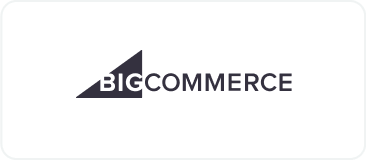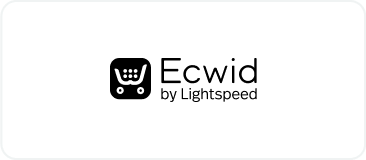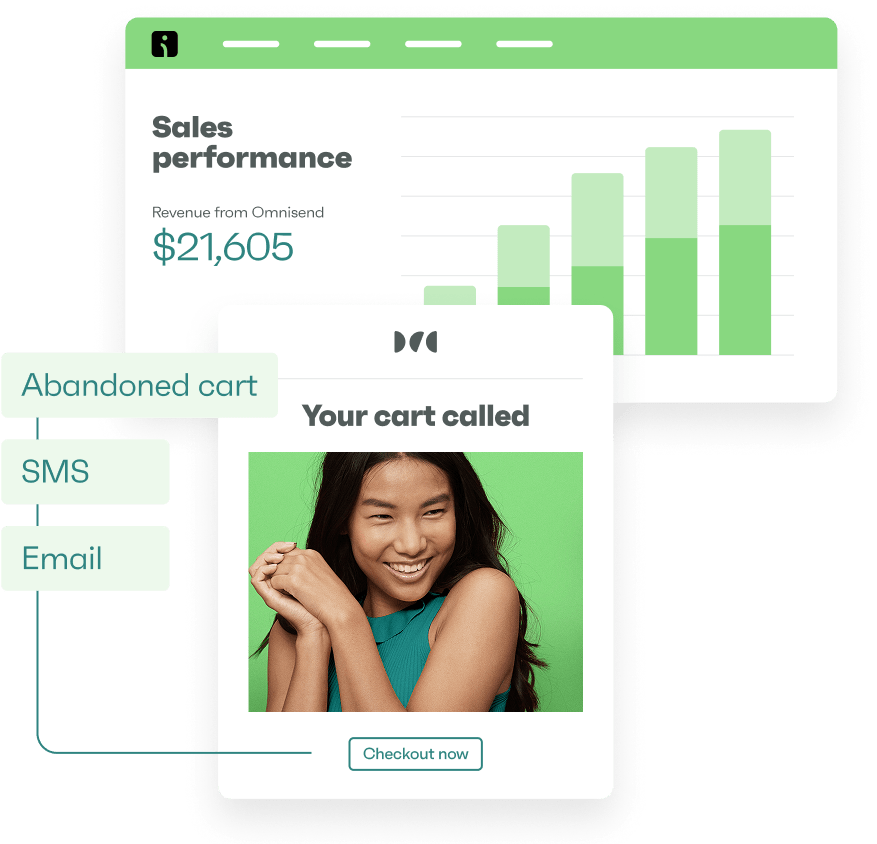Drive sales on autopilot with ecommerce-focused features
See FeaturesHave you ever spent hours crafting the perfect email, only to wonder if anyone will open and read it? Low open rates and declining clicks can be frustrating, but they don’t have to be the norm.
If your emails aren’t getting the response you hoped for, you can turn things around by measuring and improving your email engagement rate.
An unread email is a missed opportunity to boost sales, build relationships, or strengthen brand loyalty. In 2025, understanding email engagement and its key metrics will be essential for business owners who want to create effective email campaigns that truly resonate with customers.
In this article, we’ll break down what email engagement means, why it matters, and how you can measure and improve it to create campaigns that connect with your customers.
Quick sign up | No credit card required
What is email engagement?
Email engagement is defined by how much interest people show in your emails. It shows how recipients interact with your email content, whether it’s by opening, clicking links, replying, or forwarding the email.
It’s a key metric in email marketing that helps you measure the effectiveness of your email campaign.
How to measure email engagement
Measuring email engagement helps your business understand how recipients interact with your campaigns and allows you to refine strategies for better results.
This guide will show you how to measure your email engagement effectively:
1. Understand email engagement metrics
Understanding these metrics helps you refine your email content and improve targeting. This ultimately drives higher conversions, resulting in highly impactful email campaigns.
Track the following key indicators of email marketing engagement:
- Open rate
- Click-through rate (CTR)
- Conversion rate
- Bounce rate
- Unsubscribe rate
The image below shows an email analytics dashboard highlighting important engagement metrics:
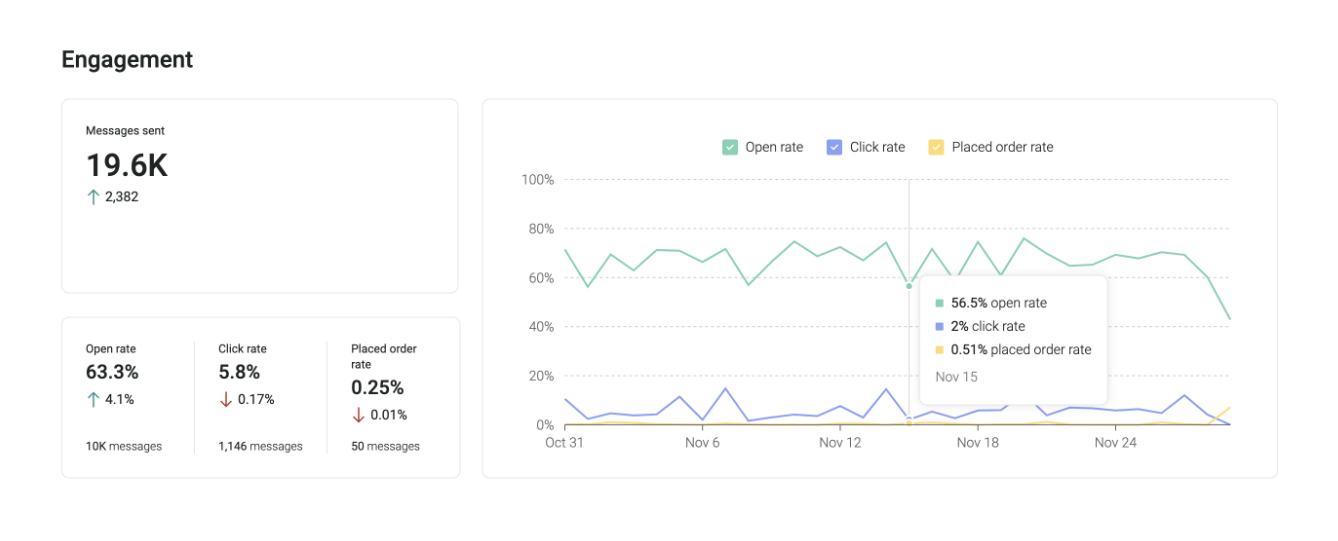
2. Use the right tools
Leverage email marketing platforms like Omnisend to track important engagement metrics like opens and click-through rates.
These tools provide valuable insights into your audience’s behavior so you can adjust your strategy, improve content relevance, and optimize delivery times for maximum engagement.
Additionally, you can use Google Analytics to see how many visitors to your website came from clicking the links in your emails. This helps you understand which campaigns are driving traffic.
3. Set clear goals
Setting goals helps ensure your campaign stays focused and aligns with your business objectives.
Define your email campaign’s purpose using this table:
| Campaign goal | Key metrics to focus on |
| Brand awareness | Track open rates to assess if your subject lines and timing are effectively capturing attention |
| Sales | Click-through and conversion rates show you how successful your email is at driving action and boosting purchases |
| Gathering feedback | Monitor reply rates to collect insights from customers |
4. Track and analyze your data
Tracking and analyzing the data from your email engagement metrics helps you fine-tune your campaigns for better results. Plus, it helps you maximize return on investment (ROI).
Track the following data for actionable insights:
- Performance trends over time: Spot emerging patterns in engagement, conversions, and traffic to refine your strategies
- Audience segmentation: Analyze your audience to create tailored content that resonates with specific groups
- Industry benchmarking: Compare your metrics with industry standards to evaluate and enhance your performance
5. Optimize your campaigns
Refine subject lines, simplify email designs, and personalize content based on data insights. Optimizing your campaigns ensures you continuously improve engagement, reduce bounce rates, and maximize conversions.
Finally, conduct A/B tests and tweak your strategy based on performance. Test elements like subject lines, calls to action, and email layouts.
By following this guide, you can start measuring email engagement effectively and optimize your campaigns for better results.
Always remember to calculate your email marketing ROI. This will help you determine how effectively your campaigns are driving engagement, which leads to optimal business results such as sales or leads.
How to improve email engagement
To improve email engagement, you first need to understand what your audience wants to see. Then, you can learn how to deliver your message to drive conversions.
Implement the following strategies to effectively boost email engagement:
1. Personalize your emails
Personalization is one of the most effective ways to engage your audience. Instead of sending generic emails, tailor your content to the individual recipient based on their past behavior, preferences, or demographic information.
Consider using email automation tools to deliver tailored content efficiently to each subscriber and catch their attention at the right time.
Here’s how to personalize your emails for maximum email engagement:
- Start your emails with a personal greeting using the recipient’s first name
- Send recommendations or offers based on past purchases or browsing history
- If relevant, include region-specific promotions or information based on the recipient’s location
2. Segment your audience
Segmentation involves dividing your email list into smaller, targeted groups based on shared characteristics or behaviors. By segmenting your audience, you can send more relevant, specific content, increasing the chances of engagement.
Segment your audience based on the following factors:
- Demographics: Age, gender, location, job title, etc.
- Behavior: Past purchases, email interactions, website visits
- Engagement level: Active subscribers, recent openers, or re-engagement targets
Tailoring content to each audience segment involves ensuring that it aligns perfectly with the stages of an email marketing funnel, making each message more relevant. Segmented emails address the unique needs of each group, helping increase your business’s conversion rate.
3. Conduct A/B testing
Before sending emails, it’s always better to experiment with different elements of your emails to see which version performs best. Testing different email elements can help you understand what resonates most with your audience and will maximize results.
A/B testing ensures that you send emails that capture your audience’s attention and lead to higher open rates, click-through rates, and conversions. It’s a valuable tool for continually optimizing your email campaigns.
The image below shows A/B testing, comparing two email versions where one highlights urgency, and the other emphasizes a 50% discount. It shows that the discount-focused message resonates more with the audience, resulting in a higher click rate (15% vs. 2%):
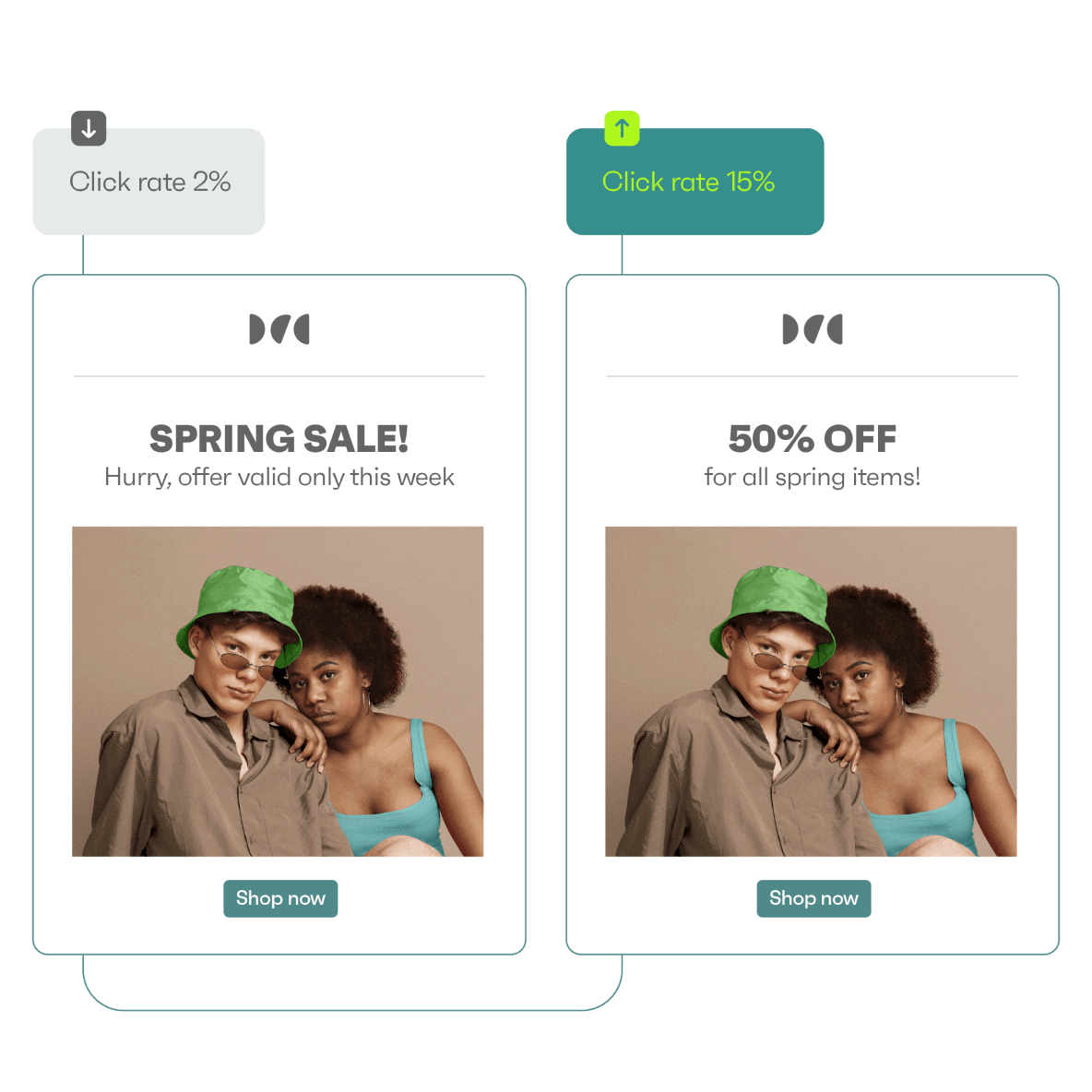
Test the following key elements of your email:
- Call to action: Experiment with different wording or placements to entice more clicks
- Email design: Try different layouts and visual elements to see which appeals most to your subscribers
- Subject line and preheaders: Experiment with different formats (e.g., questions vs. statements)
The video below explains more about maximizing email engagement with preheaders:
4. Optimize email design and user experience
The design and structure of your emails directly impact how recipients engage with your content. A visually appealing email makes it easier for subscribers to absorb information and take action. Additionally, a well-designed email is easier to read and navigate, which increases engagement rates.
Here are some useful design tips:
- Ensure emails are mobile-friendly
- Use bold CTAs that stand out
- Keep content concise, with bullet points for readability
- Include visuals that enhance rather than overwhelm
5. Test sending times
The timing of your email can have a significant impact on its engagement. Analyze previous campaign data to determine when your audience is most likely to interact.
Understanding the best time to send emails ensures that your messages reach recipients when they’re most receptive.
Optimize timing by:
- Reviewing data to identify patterns in engagement times
- Sending emails aligned with recipients’ time zones
- Testing different days and times to maximize open and click-through rates
Email engagement metrics
We’ve mentioned a few email engagement metrics earlier. Now, let’s break them down. Understanding these metrics is crucial for evaluating the success of your email campaigns.
Here are the key metrics to monitor:
Open rate
As the name implies, this metric measures the percentage of recipients who open your email. It provides insight into the effectiveness of your subject line and preheaders at grabbing your audience’s attention.
Click-through rate (CTR)
This rate tracks the percentage of recipients who click on links within your email. It reflects the relevance and appeal of your email content.
A higher click-through rate means your email content resonates with the audience, encourages further engagement, and prompts action.
Conversion rate
This important metric measures the percentage of recipients who take the desired action after clicking a link in your email. This could either be making a purchase or filling out a form.
Measuring the conversion rate is central to understanding how well your email drives impactful business outcomes.
Bounce rate
This metric indicates the percentage of emails that didn’t even reach your recipients’ inboxes. There are two types of bounces: hard bounce and soft bounce. A high bounce rate could mean there’s an issue with your email list quality or deliverability.
Unsubscribe rate
The unsubscribe rate tracks how many recipients opt out of receiving future emails. A high unsubscribe rate could signal that your emails are too frequent or irrelevant.
Understanding and monitoring these engagement metrics helps you gauge the success of your email campaigns and refine your strategies for better engagement.
Levels of email engagement
Email engagement can vary widely among your subscribers. Knowing the levels can help tailor your messaging and improve campaign performance.
Here are the key levels of email engagement:
- Highly engaged: These subscribers frequently open emails, click links, and interact with your content. Focus on nurturing this group with exclusive offers, rewards, or personalized content.
- Moderately engaged: These are the ones who open emails occasionally and interact with some content. Use segmentation and behavior-based campaigns to increase their engagement.
- Low engagement: These subscribers rarely open emails or interact with your content. Focus on re-engagement email campaigns to win them back, or consider removing them from your list if they remain inactive.
- Inactive: Subscribers who haven’t opened or interacted with your emails for six months or longer. Use a reactivation strategy with compelling offers or a survey to understand their preferences.
To ensure your email list remains healthy and active, it’s important to use re-engagement campaigns. These campaigns help you reconnect with low-engagement and inactive subscribers, reminding them of the value your brand offers and encouraging them to re-engage.
You can offer incentives, send personalized content, or simply ask if customers still wish to receive your emails. This can help revive inactive subscribers and restore them to higher engagement levels.
Email engagement examples
Successful email engagement often stems from well-executed strategies that resonate with subscribers. As a business owner, you can use techniques like personalization, timely updates, and tailored content to build stronger connections.
Here are a few engagement email marketing examples that showcase effective strategies:
Personalized product recommendations
Amazon sends personalized emails based on a customer’s browsing and purchasing history. These emails include product recommendations tailored to individual preferences, which increases the likelihood of clicks and purchases.
This customized approach boosts clicks, engagement, and conversions. The email example below shows how Amazon personalized Anson’s recommendation based on his recent activity. It also encourages action by highlighting a 47% savings if he purchases at the store price:
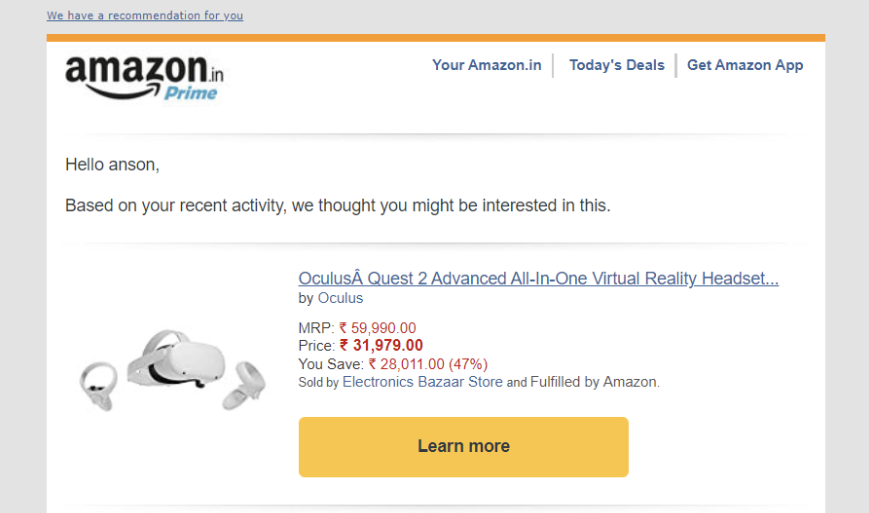
Back-in-stock alerts
Lululemon engages customers with back-in-stock emails. The brand alerts them when popular items are available again. These emails create urgency and nudge subscribers to complete their purchase before the items sell out again.
The first thing to note in this Lululemon email is how it creates a need to act with phrases like “Ready for takeoff” and “Catch these pieces before they fly away again.” Also, the high-quality product images showcasing the restocked items enhance the email’s visual appeal:
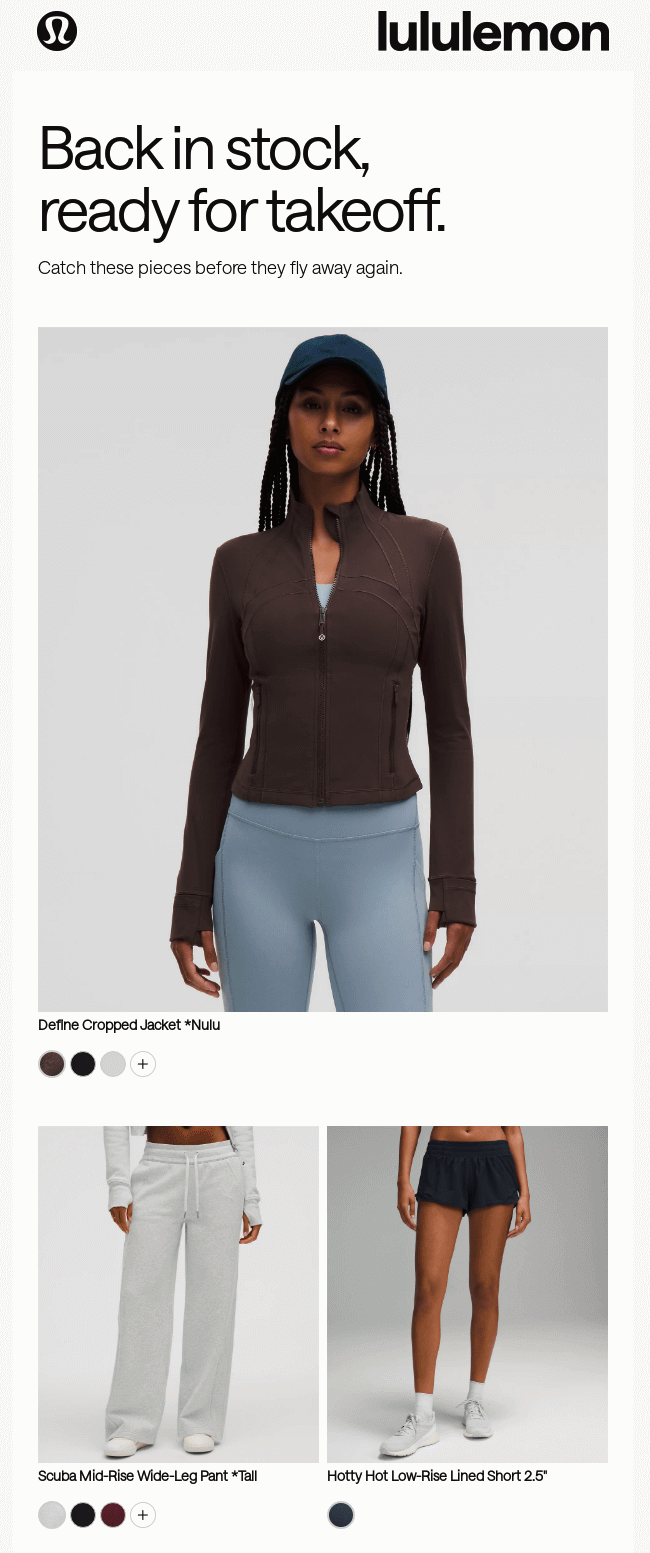
Re-engagement campaigns
Duolingo’s emails re-engage users who haven’t been active for a while. The language learning app reminds them of their learning streak and progress.
These emails often include motivational messages, personalized reminders, or special offers to inspire users to resume their language-learning journey.
This re-engagement email from Duolingo is effective because it uses a sad-looking owl mascot to appeal to subscribers’ emotions. Also, the simple yet direct copy reminds users of their language-learning goal, with the CTA “Get back on track” motivating users to take action:
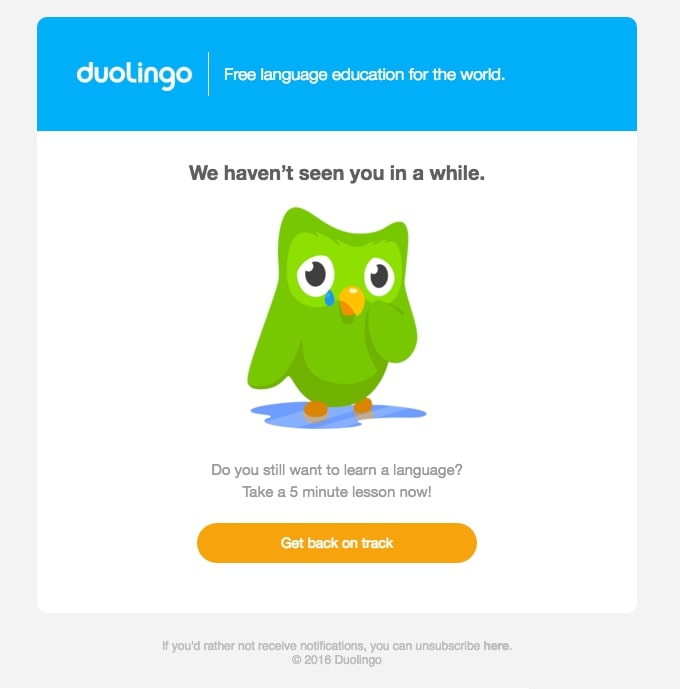
Abandoned cart email
Bite sends abandoned cart emails to remind customers of their items. The brand also offers a limited-time discount to encourage purchases. The email emphasizes the offerings’ eco-friendly benefits and a clear call to action, making it easy to complete the checkout.
Bite uses a playful and persuasive copy, “Finish what you carted,” to re-engage shoppers. The email’s visually appealing layout highlights the product image with a clear CTA button, “FINISH CHECKOUT,” to prompt action:
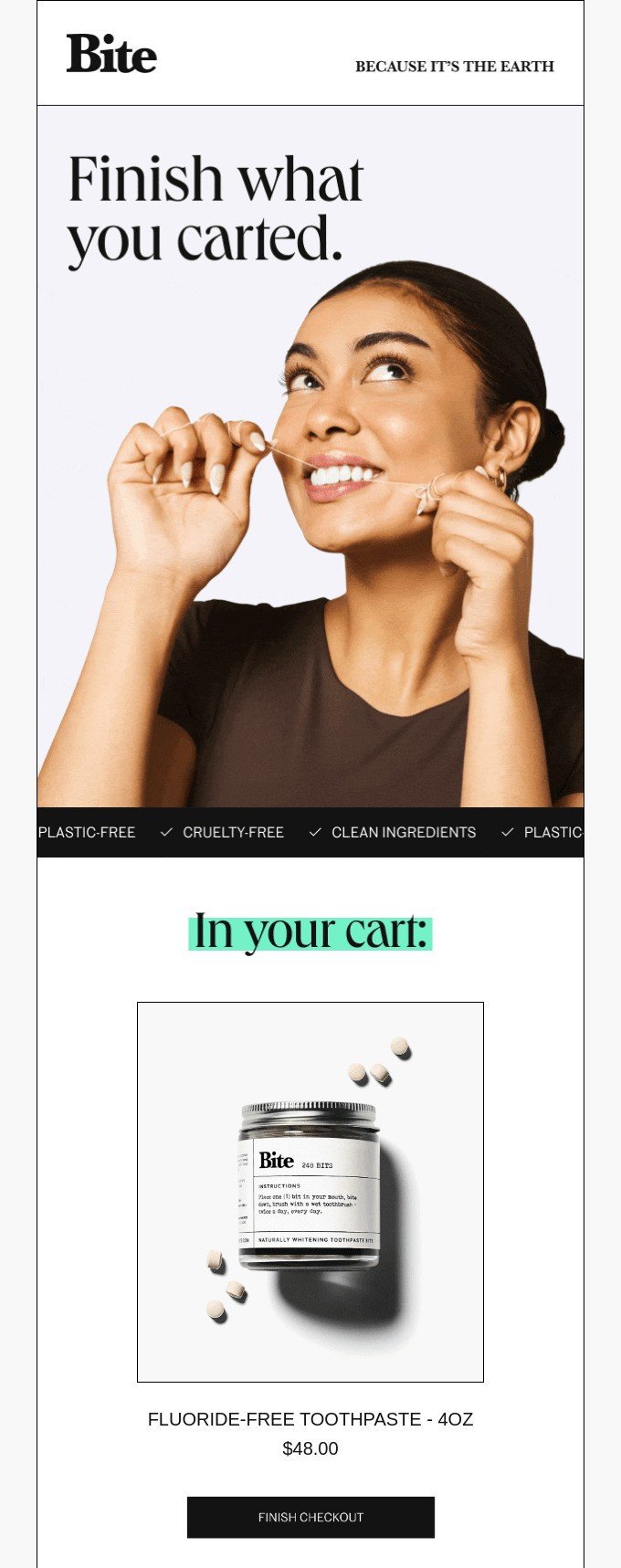
Vape Superstore success story
Vape Superstore saw 77% increase in signup rates and 80% website traffic on mobile. Watch the complete video here to see how the store grew with Omnisend’s SMS and email marketing in this video with Dan Judd, Head of Digital at Vape Superstore.
Conclusion
Email engagement is the heartbeat of successful email marketing. By leveraging personalization, segmentation, and strategic testing, your business can build stronger connections with its audience and ultimately drive conversions.
From keeping engaged subscribers interested to reaching out to inactive ones through re-engagement campaigns, understanding these factors enables you to deliver more personalized and impactful communication.
Finally, the ultimate key to email engagement is to continually analyze your results, refine your strategies, and stay attuned to your audience’s needs.
With the right approach, your email campaigns won’t just be opened — they’ll inspire action, build loyalty, and contribute to sustained growth.
Quick sign up | No credit card required
TABLE OF CONTENTS
TABLE OF CONTENTS


No fluff, no spam, no corporate filler. Just a friendly letter, twice a month.

 OFFER
OFFER


